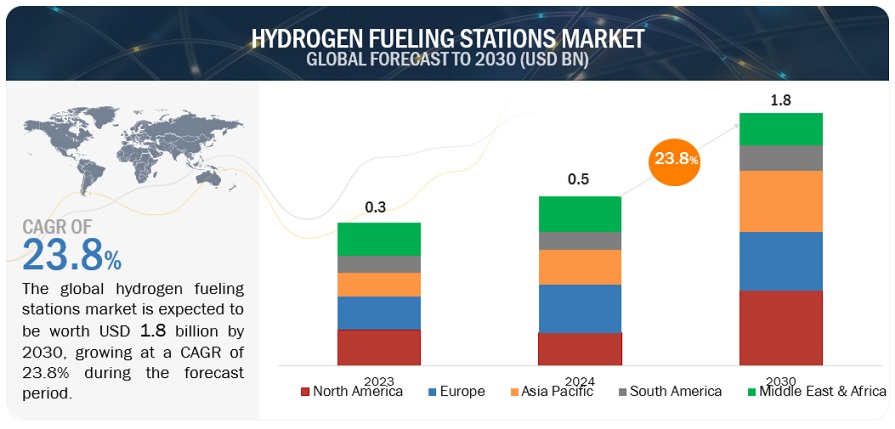According to a research report “Hydrogen Fueling Station Market by Supply Type (On-site, Off-site [Gas, Liquid]), Station Type (Fixed, Mobile), Station Size (Small, Mid-sized, Large), Pressure (High, Low), Solution (EPC, Components), Region – Global Forecast & Trends to 2030″ published by MarketsandMarkets, the hydrogen fueling stations market is expected to grow from USD 0.5 billion in 2024 to USD 1.8 billion by 2030, with a CAGR of 23.8% during the forecast period. Governments worldwide are implementing stringent environmental regulations and setting ambitious climate goals to reduce carbon emissions. Hydrogen, being a clean and renewable energy source, plays a crucial role in achieving these targets. Policies promoting the use of hydrogen as a fuel, along with incentives and subsidies for hydrogen infrastructure, are driving the growth of hydrogen fueling stations. In addition to this, Major automotive manufacturers are increasingly investing in hydrogen fuel cell vehicles (FCVs) as a sustainable alternative to traditional internal combustion engine vehicles and battery electric vehicles (BEVs).
Download PDF Brochure: https://www.marketsandmarkets.com/pdfdownloadNew.asp?id=205206436

Fixed Hydrogen Stations, by station type, are expected to be the largest-growing segment during the forecast period.
The by station size segment is bifurcated into 2 types Fixed Hydrogen Stations and Mobile Hydrogen Stations. In most cases, fixed hydrogen stations have higher storage and dispensing capacity than their mobile station counterparts, which helps them meet the high demands in busy areas. Fixed stations can be fitted into the existing infrastructure of fueling stations, such as conventional gas stations, thereby making them more accessible and convenient for consumers. Besides, fixed stations offer a stable and reliable supply of hydrogen gas without the logistical complications involved in the transportation of the mobile units from one location to another. Moreover, fixed stations are usually provided with much more support and incentives from the government, including subsidies, grants, and favorable regulations, in order to motivate them to develop and deploy.
Ask Sample Pages: https://www.marketsandmarkets.com/requestsampleNew.asp?id=205206436
Components, by solution, is expected to be the largest-growing segment during the forecast period.
The by solution segment is further bifurcated into 2 types: EPC and Components. The Continuous improvements in component technologies make them more efficient, reliable, and thus more attractive than EPC services. Mass production and economies of scale in component manufacturing have cut down on their costs significantly, hence making them more affordable and preferable to complete EPC packages. Components offer more flexibility to tune in to the individual needs of projects; independent station operators are thus better positioned to have their tailored solutions without having to be locked into one EPC provider. Ordering individual components normally brings shorter lead times compared to arranging comprehensive EPC services, thus shaving off a few weeks or even months from a project timeline and quickening overall deployment. Moreover, Components can easily be integrated into existing infrastructure to provide incremental upgrades and expansions, rather than requiring total replacement.
Asia Pacific is expected to be the largest region during the forecast period.
Countries like Japan, Korea, and China in the Asia Pacific region are home to major automobile manufacturers like Toyota, Hyundai, and Honda at the front line of hydrogen fuel cell vehicle technology. Their leadership in this commitment keeps them at the forefront in stimulating the demand for hydrogen fueling stations to support their vehicles. Moreover, the Asia Pacific countries suffer more from air pollution and hence are more willing to use clean energy solutions. Hydrogen, being a zero-emission fuel, gives them impetus on environmental grounds, resulting in more support for hydrogen fueling stations compared to those regions where the problem of pollution is not that grave. Nations like Japan and South Korea have drafted national strategies for hydrogen, clearly stipulating the objectives and roadmaps to develop hydrogen infrastructure. This sets a structured approach toward the rollout of hydrogen fueling stations, ensuring coordinated efforts across different sectors. The rapid urbanization and industrialization underway in the Asia Pacific region spur demand for clean energy solutions. The hydrogen fueling stations are part of a broader effort. These would serve two important functions: supportable urban development and the fulfillment of energy needs for increasing industrial sectors.
Make an Inquiry: https://www.marketsandmarkets.com/Enquiry_Before_BuyingNew.asp?id=205206436
Key Players
Some of the major players in the Hydrogen fueling stations market are Air Liquide (France), Linde PLC (Ireland), Air Products and Chemicals, Inc. (US), Nel ASA (Norway), MAXIMATOR Hydrogen GmbH (Germany) and Hydrogen Refueling Solutions (France) among others. The major strategies adopted by these players include new product launches, acquisitions, contracts, agreements, partnerships, joint ventures, collaborations, investments, and expansions.
Browse Related Reports
Hydrogen Storage Tanks and Transportation Market by Modular Storage (Fuel Storage, Distribution Systems), Application (Vehicles, Railways, Marine, Stationary Storage, Trailers), Tank Type (Type 1, 2, 3, 4), Pressure and Region – Global Forecast to 2030
Hydrogen Generation Market by Technology (SMR, ATR, POX, Coal Gasification, Electrolysis), Application (Refinery, Ammonia, Methanol, Transportation, Power Generation), Source (Blue, Green, Gray), Generation Mode Region – Global Forecast to 2028
Hydrogen Energy Storage Market by Form (Gas, Liquid, Solid), Technology (Compression, Liquefaction, Material Based), Application (Stationary Power, Transportation), End User (Electric Utilities, Industrial, Commercial) Region – Global Forecast to 2028


